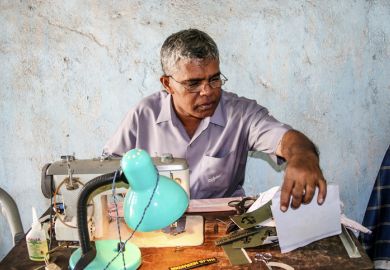The rapid expansion of higher education in Africa over the past 30 years has led to a huge rise in the number of universities across the continent, as well as in the number of students who enrol in them.
However, as is often the case with rapid growth, quality has not kept pace with the rate of expansion. And, at the same time, the dream of a pan-African higher education system that allows academics and graduates to move freely around the continent remains a long way off.
The African Union is determined to tackle this and has outlined a vision of building an “integrated Africa”: its Agenda 2063 calls for the harmonisation and strengthening of the quality of higher education in Africa to make it both “locally relevant and globally competitive”.
In partnership with the European Union, the AU set up the Harmonisation of African Higher Education Quality Assurance and Accreditation Initiative to support the development of a consistent quality assurance and accreditation system at institutional, national, regional and continental level.
Development of the African Standards and Guidelines for Quality Assurance in Higher Education started in 2016, and the finalised version was published by the initiative in 2018. The guidelines set out what universities and quality assurance agencies should do when it comes to internal and external quality assurance, so that universities in Africa can be regulated by comparable standards.
They cover how to build policies around quality in teaching, assessment, governance structures, admissions within universities – to name a few – as well as how universities and national quality assurance agencies should go about evaluating quality, internally and externally.
According to the guidelines, the goal is not that every institution or country in Africa operates in a single, uniform way, but to ensure that the basic framework for quality is equal – and comparable.
However, it one thing to have a set of standards, another to implement them across a continent with a large number of different national, regional and institutional structures.
For example, although the guidelines are in English, French, Arabic and Portuguese – the four main languages of the continent – many other languages are used across higher education institutions. The guidelines will need to be translated and disseminated, and work will have to continue across these language barriers in the future.
Those involved in the consortium implementing the initiative and national quality assurance agencies have already begun to disseminate the guidelines, although they still await official endorsement by higher education ministers in the AU.
However, the need for improved standards across African higher education is urgent. Cases of fraud have a damaging impact on the reputation of universities on the continent: last year, the murder of a senior academic in South Africa was linked to the fraudulent awarding of PhDs at his institution.
A lack of oversight within and across countries has led to complaints from employers that too many graduates are of poor quality and that the levels of quality vary from nation to nation. There is a stark difference between a degree from a university in Somalia and South Africa, it is argued, but no assessment reflecting that difference.
Gerald Ouma, director of planning at the University of Pretoria, pointed out that many employers have said many of Africa’s graduates do not have the right technical skills for the types of jobs that are needed in the fourth industrial revolution. However, in South Africa, they are more likely to say that graduates have the technical skills but lack the communication or critical thinking skills needed.
Many African nations also find variations within their own systems: public universities are more likely to be regulated than those in the private sector, although in some countries the private sector has access to more resources.
And all this diversity has resulted in a lack of mutual recognition of degrees and in barriers to academic mobility, meaning that scholars are not able to move around the continent as freely as they would like and graduates are not able to find work in other countries in order to drive economic growth.
Violet Makuku, project officer for the African quality assurance initiative, said that it had “slightly dampened” her spirits that they had finalised the standards and guidelines in 2018 but official endorsement would have to wait until 2020-21, as ministers would need to meet and discuss the standards. This has to be done according to the AU meeting schedule.
“The red tape and bureaucracy is [what] always holds things back,” she said. “But it doesn’t stop me working. I am moving the guidelines forward; I am pushing the quality recommendations…In [individual countries] we are spreading the gospel: push for ratification.”
Dr Makuku said that some countries, such as Zimbabwe, had taken up the cause with gusto. “There are a lot of political challenges going on there, but I would applaud the Zimbabwean Council for Higher Education for the sterling job they have done. The whole country now has a minimum body of quality – and they have then shared their work with the wider region,” she said. “If all the regions were this proactive – and did not try to be selfish and keep the information to themselves – we really would be somewhere.”
Political instability is also a problem: after convincing one government to make quality in higher education a priority, it can be quickly replaced by another.
“In some countries a new government is formed and they say ‘we do not take up the tasks started by the old government’, and you have to start again,” said Dr Makuku. “We have to convince them that this is bigger than party politics.”
The same problem applies to individual vice-chancellors and their management teams, according to Rispa Odongo, a member of Kenya’s Commission for Higher Education and the chair of a technical working group that helped to create the new guidelines. “You find a vice-chancellor who is very keen on quality, but then suddenly they and the top management team have left and you have to start again. It can regress,” she said.
Dr Odongo added that funding was another challenge. “Quality assurance is not cheap: you have to undertake self-assessment, then there are external reviews,” she said. There is also a need for adequate financing for this increasing demand for higher education, and consequently management of the available limited resources, she said.
According to the guidelines, “funding should be secured in the long term in order to develop stable and resourced higher education systems throughout the whole continent”.
Peter Okebukola, professor of science and computer education at the University of Lagos, in Nigeria, said that this could be difficult. “The sustainable funding of higher education in Africa is an issue. There is always the worry it could slow down more,” he said.
Despite this, Professor Okebukola was confidently optimistic about the implementation of the guidelines across Africa. “In 2019, in Nigeria, we’re moving very well on this, I’m confident in the next five years we’ll see it widely adopted,” he said.
For Pretoria’s Dr Ouma, the guidelines are a “good reference document for countries that don’t have robust quality assurance systems, and it’s even useful for those who do to have a look and see if they have any gaps”.
However, he said the challenge would be the implementation. “Statutory bodies are responsible for quality and they can’t just wake up and introduce it, there needs to be engagement first,” he said. Dr Ouma said he has not seen much mobilisation around the standards or conversations about the guidelines: “It’s difficult to see how it will trickle into universities and be institutionalised.”
He added that one aspect that had surprised him was that, although the guidelines discuss admissions, they were “quite silent on the support that needs to be given to weak students to ensure they excel” as dropout rates are high in many African countries, including South Africa.
“It would be useful to know how the quality assurance systems play a role in ensuring students leave with the right skills,” he said.
Dr Odongo, who has worked on the guidelines from the start, is confident that the initiative can in time overcome all the challenges, “particularly as ensuring high quality is integral for institutions to remain competitive”, she said.
“If you want to attract the most and best students, it is important you are able to show you are of a certain quality. It tells institutions they can be proud of themselves, and that response has been very positive,” she said.
anna.mckie@timeshighereducation.com
What the guidelines say:
- Institutions must have a published vision and mission statement that reflect its “commitment to continuous quality enhancement”.
- Institutions must have clearly stated governance and management structures, as well as policies that ensure the recruitment of qualified, competent staff, along with adequate resources and infrastructure to support teaching and learning.
- Institutions must ensure that they have fair and equal recruitment and admissions policies, along with fair and transparent assessment standards and procedures that are made explicit to staff and students.
- Institutions should engage in innovative research that address national, regional and international needs, and plans that ensure “quality ethical research”.
- Institutions must subject themselves to periodic external assessment.
- National and regional quality assurance agencies must be autonomous legal entities with a clearly defined mandate, scope and powers. These agencies must also undergo periodic internal and external reviews.
POSTSCRIPT:
Print headline: Can quality drive realise the dream of African unity?
Register to continue
Why register?
- Registration is free and only takes a moment
- Once registered, you can read 3 articles a month
- Sign up for our newsletter
Subscribe
Or subscribe for unlimited access to:
- Unlimited access to news, views, insights & reviews
- Digital editions
- Digital access to THE’s university and college rankings analysis
Already registered or a current subscriber? Login






